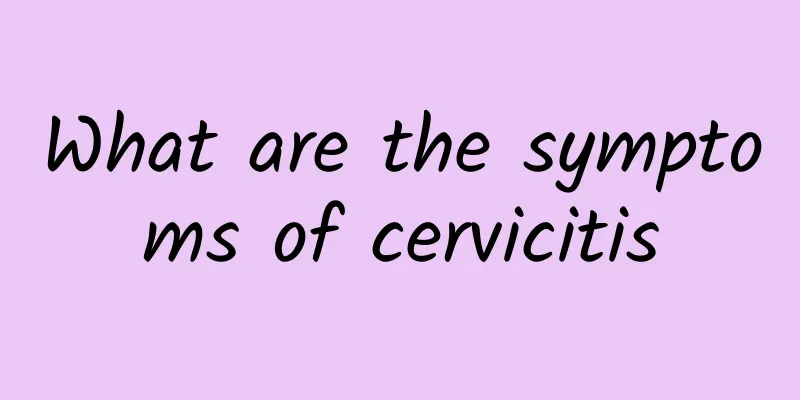How is viral cervical erosion formed? What are the treatment methods for female cervical erosion?

|
Cervical erosion is the most common gynecological disease in life, which poses a great threat to women's health. According to its cause, cervical erosion caused by the invasion of bacteria and viruses is viral cervical erosion, which also occurs frequently in clinical practice. Women may suffer from viral cervical erosion due to unclean sexual life, hygienic habits, or excessive cleaning that leads to inflammation and infection. To treat viral cervical erosion, it is advisable to identify the specific pathogen and treat it symptomatically. What causes viral cervical erosion? Cervical erosion is not an independent disease, but a manifestation of chronic cervicitis. The causes of the disease include mechanical stimulation or damage, such as sexual intercourse, miscarriage and delivery lacerations and bacterial invasion. Long-term chronic mechanical stimulation is the main cause of cervicitis. Cervical erosion occurs due to childbirth, miscarriage, puerperal infection or surgical operation or mechanical stimulation such as sexual intercourse that damages the cervix, and pathogens invade and cause infection. Since the penis and cervix are in direct contact during sexual intercourse, if you do not pay attention to sexual hygiene, you can directly bring bacteria into the vagina, infect the cervix and cause cervical erosion. Symptoms of viral cervical erosion Viral cervicitis is often accompanied by vaginitis, mostly due to infection after sexual intercourse with a male with a viral infection; it may also be an indirect infection. After the viral infection, it takes 3 to 7 days for the disease to develop. After the first infection, there is obvious general discomfort, fatigue, low fever, headache, etc. During gynecological examination, it can be seen that the vulva, vagina, and cervix are red and swollen with pain, and scars or ulcers form on the surface of the cervix. Generally, no scars are left after the diseased surface heals. The course of the disease can last up to 6 weeks. After the initial infection of the herpes virus, the virus may lurk in the lesion and be stored in the dorsal root of the ganglion for a long time until the next attack. If the second relapse occurs, the condition is generally milder than the first time. How to treat viral cervical erosion 1. Drug treatment: For patients with small erosion and shallow inflammatory infiltration, the following drug treatment methods can be used Potassium permanganate: Apply topically after menstruation, and repeat the application 1 to 2 months later. When using the above drugs, be careful to prevent burns to the surrounding vaginal wall, and pay attention to disinfection during use to prevent repeated infection. 2. Physical therapy: used for cervical erosion with a large erosion area and deep inflammatory infiltration. ① Electric ironing: Use a special electric iron to burn the eroded surface tissue, causing it to necrotize and fall off, and the ironing must reach a certain depth, so that the treatment effect is good. ② Laser treatment: Carbon dioxide laser therapy device is often used. A special laser treatment head is used to irradiate the cervical erosion tissue, causing the erosion tissue to carbonize, crust, and fall off, and then new squamous epithelium will grow again. Generally, it can be cured in one session. There is no special discomfort during the operation. A few patients may bleed when the scab falls off. ③KS instrument treatment: It is a treatment using special wavelengths of light and heat, which is painless and effective. During the treatment with the above methods, attention should be paid to the cleanliness of the vulva, and sexual intercourse, vaginal lavage and sitting baths are prohibited. Regular check-ups should also be conducted to observe the healing of the erosion surface. ④ Cryotherapy: Use a special rapid freezing device to freeze, necrotize, and fall off the lesion tissue on the cervical erosion surface. The commonly used cryogen is liquid nitrogen, which can reduce the temperature of the freezing head of the freezer to -196 degrees Celsius. It is placed on the surface of the cervix to freeze the eroded tissue to necrotize and fall off, and then new epithelial tissue will grow again. It can be cured in one time. Generally, there are no adverse reactions. A few patients have mild dizziness, lower abdominal pain, etc. 3. Surgical treatment: For patients who are not responsive to medication and physical therapy, have deep or large cervical erosion, have cervical hypertrophy, or are suspected of having cancer, cervical cone resection or total hysterectomy may be considered. Warm reminder: For the treatment of patients with viral cervical erosion, first do a cervical smear to exclude precancerous lesions, and then do a pathogen test of cervical secretions to confirm which pathogen is causing it. If necessary, pathogen culture + drug sensitivity can be done to select sensitive drugs for treatment. Drug treatment includes local medication and systemic medication, but physical therapy is better for the treatment of moderate and severe cervical erosion, such as: laser, microwave, Bohm light, red light, LEEP knife, etc. It is recommended to choose a treatment method suitable for the condition under the guidance of a doctor and conduct standardized treatment. |
Recommend
Why is congenital absence of vagina always difficult to cure?
The high incidence of congenital absence of vagin...
Can I have a baby if I have Bartholin's glanditis?
Can you get pregnant and have a baby if you have ...
Experts introduce you to the examination and diagnosis methods of vaginitis
There are more and more patients with vaginitis i...
Combined with the clinical manifestations of irregular menstruation, the patient's condition can be discovered in time
Irregular menstruation is a common phenomenon in ...
Specific introduction to the diet method for patients with vaginitis
A good diet for vaginitis is not only helpful for...
What are the early symptoms of ovarian cysts?
Nowadays, many women may have ovarian cysts, whic...
Eat Zongzi to lose weight! 9-grid food sharing + 3 low and 1 high
The Dragon Boat Festival is approaching. When peo...
Chinese patent medicine for the treatment of premature ovarian failure
Chinese patent medicine for the treatment of prem...
Difficulty breathing during weight loss is caused by excessive exercise
People who want to lose weight often do too much ...
Experts explain the symptoms of uterine fibroids
What are the symptoms of uterine fibroids? Uterin...
Eating pumpkin can improve metabolic syndrome! Nutritionist Xie Yifang reveals: 4 benefits of nutritious light meals
More than half of the top ten causes of death in ...
The harm of uterine fibroids can cause many adverse symptoms
How many harmful manifestations does uterine fibr...
When is the best time to check for pelvic effusion and what method is best used?
When is the best time to check for pelvic effusio...
What causes uterine fibroid pain? What to do if uterine fibroid pain
What causes uterine fibroid pain? What to do if u...
What are the precautions for bacterial vaginosis
What are the precautions for bacterial vaginosis?...









